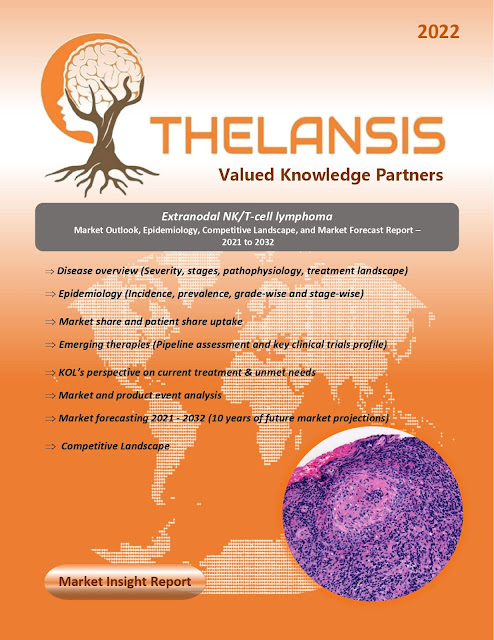Extranodal NK/T-cell Lymphoma – Market Outlook, Epidemiology, Competitive Landscape, and Market Forecast Report – 2021 To 2032
Extranodal NK/T-cell lymphoma is a
rare form of non-Hodgkin lymphoma that is strongly linked to the Epstein-Barr
virus (EBV). The most common cause of this so-called "lethal midline
granuloma" manifests almost exclusively in non-nodal sites, most commonly
as stage IE/IIE disease in the nose, nasopharynx, oropharynx, and upper
aerodigestive tract. Other skin and gastrointestinal tract sites can be involved
in more advanced stages. Lymph nodes may have secondary involvement but are
generally not the disease's primary site. Given the typical anatomic sites of
involvement, the majority of patients present with nasal obstruction or
epistaxis; some present with destructive masses involving the nose, sinuses, or
palate. Approximately 3% of patients with ENKTL present with hemophagocytic
lymphohistiocytosis syndrome characterised by high fevers, cytopenia, abnormal
liver function tests, and high ferritin levels due to pathologic immune
activation. The typical immunophenotype of ENKTL is similar to that of an NK
cell: CD45(+bright), CD2(+), surface CD3(−), cytoplasmic CD3 epsilon(+),
CD56(+bright), CD16(−/+), T-cell receptor (TCR) (−), and cytotoxic granule
molecules such as granzyme B, TIA-1, and perforin(+). CD30 is variably
expressed, often in larger malignant cells, leading to misdiagnosing anaplastic
large cell lymphoma. The prognosis for ENKTL varies, but it is especially poor
for patients with high-risk disease, as described by the prognostic index for
natural killer cell lymphoma (PINK-E).
·
The incidence of Extranodal NK/T-cell lymphoma
is low in the United States and Europe, ranging between 0.25% to 0.5% of all
newly diagnosed non-Hodgkin lymphomas.
Thelansis’s “Extranodal NK/T-cell
Lymphoma Market Outlook, Epidemiology, Competitive
Landscape, and Market Forecast Report – 2021 To 2032" covers disease
overview, epidemiology, drug utilization, prescription share analysis,
competitive landscape, clinical practice, regulatory landscape, patient share,
market uptake, market forecast, and key market insights under the potential Extranodal
NK/T-cell Lymphoma treatment modalities options for eight major markets (USA,
Germany, France, Italy, Spain, UK, Japan, and China).
KOLs insights
of Extranodal NK/T-cell Lymphoma across 8 MM market from the centre of
Excellence/ Public/ Private hospitals participated in the study. Insights
around current treatment landscape, epidemiology, clinical characteristics,
future treatment paradigm, and Unmet needs.
Extranodal NK/T-cell Lymphoma Market Forecast Patient
Based Forecast Model (MS. Excel Based Automated Dashboard), which Data Inputs
with sourcing, Market Event, and Product Event, Country specific Forecast
Model, Market uptake and patient share uptake, Attribute Analysis, Analog
Analysis, Disease burden, and pricing scenario, Summary, and Insights.
Thelansis Competitive Intelligence (CI) practice
has been established based on a deep understanding of the pharma/biotech
business environment to provide an optimized support system to all levels of
the decision-making process. It enables business leaders in forward-thinking
and proactive decision-making. Thelansis supports scientific and commercial
teams in seamless CI support by creating an AI/ ML-based technology-driven
platform that manages the data flow from primary and secondary sources.




Comments
Post a Comment